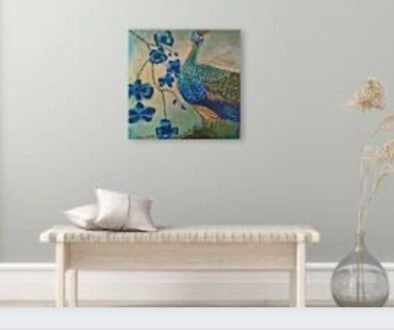Acrylic Painting – A Joyful Experience!
Wikipedia, defines Art as a “Diverse range of (products of) human activities involving creative imagination to express technical proficiency, beauty, emotional power, or conceptual ideas.”
From time immemorial people have been using various materials and mediums to express themselves. The term “medium” was first used specifically to mean different materials used to create art. Artists have always chosen the medium that fit their skills and suit artistic style. Back in the day, the caveman ground coal and used it to draw on Altamira cave walls. A variety of vegetable dyes were processed for artistic creations. Today we have a whole range of media to work with, including digital media, where art is created either entirely on the computer or hand-drawn images scanned into a computer and finished with software like Adobe illustrator.
Artists, from Pablo Picasso and Marcel Duchamp to more contemporary artists, have established that art can be made of absolutely any material. Many contemporary artworks are made from a variety of materials and the term “mixed media” has been coined to take account of this. If you visit art museums, you will find next to an artwork, a small display card that states the title of the work of art, the name of the artist and the medium from which the work of art was made. For example, a painting like Van Gogh’s “Starry Night” would be accompanied by a listing of “oil on canvas”.
Today’s artist is spoilt for choice as there is a huge variety of art media available. To name a few there are-
- Tempera
- Oil Paints
- Acrylic paints
- Watercolors
- Charcoal
- Pastels
- Chalk
Out of these, charcoal and oil paints are among the oldest media. Oil paints were used in Europe since the 12th century.
Oil paints are one of the great classic media. They have been used for hundreds of year’s and have stood the test of time with durability and steadfast colour – they have a slow drying time, during which the colours do not change and are very forgiving, allowing the artist to rework and make changes. Oil paints are mixed with solvents linseed oil and turpentine oil.
Acrylic paint is a fairly recently developed medium compared oil and watercolor painting. It is water-soluble when wet and yet because it is a plastic polymer, it dries into a flexible, water-resistant, and durable surface to which more layers of paint can be added. Oil painting techniques can be used in acrylic art and acrylic paint lends itself to transparent watercolour techniques as well.
Mixed-media on paper – shop these now on
https://www.etsy.com/shop/RengeBySabrina
Here is why acrylic paints are fast becoming the preferred medium.
Acrylics are not a high-maintenance medium. While you will need many supplies to begin oil painting (paint, solvents, rags and a ventilated space), you need just four simple tools to get started with acrylics: the paint itself, a brush, a cup of water, and a surface to work on.
You can control the consistency of acrylic paints. One of the most significant qualities of acrylics paints is their malleability. If you add a medium that thins or thickens your material––acrylics can take on the qualities of other paints. For example, if you add an acrylic retarder with your paint, it will retard and slow down the drying time, so that acrylic paints can be worked like oil paints. You can also add mediums to create awesome effects with acrylic paints- you can make your acrylics crackle, shimmer or glow.
Acrylics are non-toxic and are among the most versatile mediums to work with. As no toxic solvents are used to mix the paints, acrylic paints poses lesser health hazards and acrylic painting can be done anywhere. Oil-based paints on the other hand have a high level of toxicity and if there’s no ventilation in the artists work-space, solvents like turpentine emit toxic fumes, making it difficult to breathe at times. In recent times, water-soluble oil paints have been developed, however, they lack the versatility of acrylic paints. Mineral oil solvents give me a high – not the most desirable situation while painting!
Mixed-media on paper – shop these now on
https://www.etsy.com/shop/RengeBySabrina
One of the reasons artists are like me are so drawn to acrylic paints is because of how quickly they dry – you can finish a painting in a day! You can apply layers of colour on top of one another very quickly and create a very interesting glaze. I love creating glazes!
Another aspect of acrylics is their ability to take on three-dimensional form. While oil paints, watercolor, etc, adhere to the surface of the support – acrylic paints on the other hand being malleable have a sculptural quality and can be textured as desired.
To quote acrylic art gurus like Nancy Reyner and Annie Gonzales, there is no end to the techniques you can employ with acrylic paints and no end to the effects you can create with acrylic painting. So go for it!








